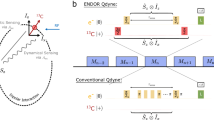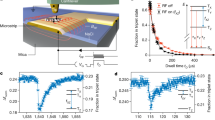Abstract
The detection and characterization of paramagnetic species by electron spin resonance (ESR) spectroscopy is widely used throughout chemistry, biology and materials science1, from in vivo imaging2 to distance measurements in spin-labelled proteins3. ESR relies on the inductive detection of microwave signals emitted by the spins into a coupled microwave resonator during their Larmor precession. However, such signals can be very small, prohibiting the application of ESR at the nanoscale (for example, at the single-cell level or on individual nanoparticles). Here, using a Josephson parametric microwave amplifier combined with high-quality-factor superconducting microresonators cooled at millikelvin temperatures, we improve the state-of-the-art sensitivity of inductive ESR detection by nearly four orders of magnitude4,5. We demonstrate the detection of 1,700 bismuth donor spins in silicon within a single Hahn6 echo with unit signal-to-noise ratio, reduced to 150 spins by averaging a single Carr–Purcell–Meiboom–Gill sequence7. This unprecedented sensitivity reaches the limit set by quantum fluctuations of the electromagnetic field instead of thermal or technical noise, which constitutes a novel regime for magnetic resonance. The detection volume of our resonator is ∼0.02 nl, and our approach can be readily scaled down further to improve sensitivity, providing a new versatile toolbox for ESR at the nanoscale.
This is a preview of subscription content, access via your institution
Access options
Subscribe to this journal
Receive 12 print issues and online access
$259.00 per year
only $21.58 per issue
Buy this article
- Purchase on Springer Link
- Instant access to full article PDF
Prices may be subject to local taxes which are calculated during checkout




Similar content being viewed by others
References
Schweiger, A. & Jeschke, G. Principles of Pulse Electron Paramagnetic Resonance (Oxford Univ. Press, 2001).
Yoshimura, T. et al. In vivo EPR detection and imaging of endogenous nitric oxide in lipopolysaccharide-treated mice. Nature Biotechnol. 14, 992–994 (1996).
Garbuio, L. et al. Orthogonal spin labeling and Gd(III)nitroxide distance measurements on bacteriophage t4-lysozyme. J. Phys. Chem. B 117, 3145–3153 (2013).
Sigillito, A. J. et al. Fast, low-power manipulation of spin ensembles in superconducting microresonators. Appl. Phys. Lett. 104, 222407 (2014).
Artzi, Y., Twig, Y. & Blank, A. Induction-detection electron spin resonance with spin sensitivity of a few tens of spins. Appl. Phys. Lett. 106, 084104 (2015).
Hahn, E. L. Spin echoes. Phys. Rev. 80, 580–594 (1950).
Mentink-Vigier, F. et al. Increasing sensitivity of pulse EPR experiments using echo train detection schemes. J. Magn. Reson. 236, 117–125 (2013).
Wrachtrup, J., Von Borczyskowski, C., Bernard, J., Orritt, M. & Brown, R. Optical detection of magnetic resonance in a single molecule. Nature 363, 244–245 (1993).
Grinolds, M. S. et al. Subnanometre resolution in three-dimensional magnetic resonance imaging of individual dark spins. Nature Nanotech. 9, 279–284 (2014).
Hoehne, F. et al. Lock-in detection for pulsed electrically detected magnetic resonance. Rev. Sci. Instrum. 83, 043907 (2012).
Morello, A. et al. Single-shot readout of an electron spin in silicon. Nature 467, 687–691 (2010).
Manassen, Y., Hamers, R. J., Demuth, J. E. & Castellano, A. J. Jr . Direct observation of the precession of individual paramagnetic spins on oxidized silicon surfaces. Phys. Rev. Lett. 62, 2531–2534 (1989).
Rugar, D., Yannoni, C. S. & Sidles, J. A. Mechanical detection of magnetic resonance. Nature 360, 563–566 (1992).
Wallace, W. J. & Silsbee, R. H. Microstrip resonators for electron-spin resonance. Rev. Sci. Instrum. 62, 1754–1766 (1991).
Narkowicz, R., Suter, D. & Stonies, R. Planar microresonators for EPR experiments. J. Magn. Reson. 175, 275–284 (2005).
Benningshof, O. W. B., Mohebbi, H. R., Taminiau, I. A. J., Miao, G. X. & Cory, D. G. Superconducting microstrip resonator for pulsed ESR of thin films. J. Magn. Reson. 230, 84–87 (2013).
Bergeal, N. et al. Phase-preserving amplification near the quantum limit with a Josephson ring modulator. Nature 465, 64–68 (2010).
Zhou, X. et al. Highgain weakly nonlinear flux-modulated Josephson parametric amplifier using a squid array. Phys. Rev. B 89, 214517 (2014).
Caves, C. M. Quantum limits on noise in linear amplifiers. Phys. Rev. D 26, 1817–1839 (1982).
Castellanos-Beltran, M. A., Irwin, K. D., Hilton, G. C., Vale, L. R. & Lehnert, K. W. Amplification and squeezing of quantum noise with a tunable Josephson metamaterial. Nature Phys. 4, 929–931 (2008).
Vijay, R., Slichter, D. H. & Siddiqi, I. Observation of quantum jumps in a superconducting artificial atom. Phys. Rev. Lett. 106, 110502 (2011).
Teufel, J. D., Donner, T., Castellanos-Beltran, M. A., Harlow, J. W. & Lehnert, K. W. Nanomechanical motion measured with an imprecision below that at the standard quantum limit. Nature Nanotech. 4, 820–823 (2009).
Stehlik, J. et al. Fast charge sensing of a cavity-coupled double quantum dot using a Josephson parametric amplifier. Phys. Rev. Appl. 4, 014018 (2015).
Hatridge, M., Vijay, R., Slichter, D. H., Clarke, J. & Siddiqi, I. Dispersive magnetometry with a quantum limited SQUID parametric amplifier. Phys. Rev. B 83, 134501 (2011).
Feher, G. Electron spin resonance experiments on donors in silicon. i. Electronic structure of donors by the electron nuclear double resonance technique. Phys. Rev. 114, 1219–1244 (1959).
Morley, G. W. et al. The initialization and manipulation of quantum information stored in silicon by bismuth dopants. Nature Mater. 9, 725–729 (2010).
Dreher, L. et al. Electroelastic hyperfine tuning of phosphorus donors in silicon. Phys. Rev. Lett. 106, 037601 (2011).
Wolfowicz, G. et al. Atomic clock transitions in silicon-based spin qubits. Nature Nanotech. 8, 561–564 (2013).
Weis, C. D. et al. Electrical activation and electron spin resonance measurements of implanted bismuth in isotopically enriched silicon-28. Appl. Phys. Lett. 100, 172104 (2012).
Ranjan, V. et al. Probing dynamics of an electron–spin ensemble via a superconducting resonator. Phys. Rev. Lett. 110, 067004 (2013).
Acknowledgements
The authors acknowledge technical support from P. Sénat, D. Duet, J.-C. Tack, P. Pari, P. Forget, as well as useful discussions within the Quantronics Group. The authors also acknowledge support from the European Community's Seventh Framework Programme (FP7/2007-2013) through European Research Council grants nos. 615767 (CIRQUSS), 279781 (ASCENT) and 630070 (quRAM) and through the QIPC project SCALEQIT, and from C'Nano IdF through the QUANTROCRYO project. J.J.L.M. is supported by the Royal Society. C.C. Lo is supported by the Royal Commission for the Exhibition of 1851. B. Julsgaard and K. Mølmer acknowledge support from the Villum Foundation. C.D.W. and T.S. acknowledge support from the Office of Science of the US Department of Energy under contract no. DE-AC02-05CH11231.
Author information
Authors and Affiliations
Contributions
A.B., J.J.P., J.J.L.M. and P.B. designed the experiment. X.Z. and D.V. designed and fabricated the Josephson parametric amplifier. C.C.L., C.D.W., T.S. and M.L.W.T. provided the Bi-implanted isotopically purified Si sample. A.B., J.J.P., and Y.K. fabricated the sample and performed the measurements. A.B., J.J.P., Y.K., J.J.L.M. and P.B. analysed the data. A.B., J.J.P., B.J. and K.M. performed the numerical simulations. J.J.L.M., D.E., D.V. and P.B. supervised the project. A.B., J.J.P., Y.K., M.S., D.V., D.E., B.J., K.M., J.J.L.M. and P.B. all contributed to the writing of the paper.
Corresponding author
Ethics declarations
Competing interests
The authors declare no competing financial interests.
Supplementary information
Supplementary information
Supplementary information (PDF 817 kb)
Rights and permissions
About this article
Cite this article
Bienfait, A., Pla, J., Kubo, Y. et al. Reaching the quantum limit of sensitivity in electron spin resonance. Nature Nanotech 11, 253–257 (2016). https://doi.org/10.1038/nnano.2015.282
Received:
Accepted:
Published:
Issue Date:
DOI: https://doi.org/10.1038/nnano.2015.282
This article is cited by
-
Electromagnetic response of the surface states of a topological insulator nanowire embedded within a resonator
Communications Physics (2023)
-
Broadband squeezed microwaves and amplification with a Josephson travelling-wave parametric amplifier
Nature Physics (2023)
-
Single-electron spin resonance detection by microwave photon counting
Nature (2023)
-
Magnetometry of neurons using a superconducting qubit
Communications Physics (2023)
-
Coupling Sub-nanoliter BDPA Organic Radical Spin Ensembles with YBCO Inverse Anapole Resonators
Applied Magnetic Resonance (2023)



